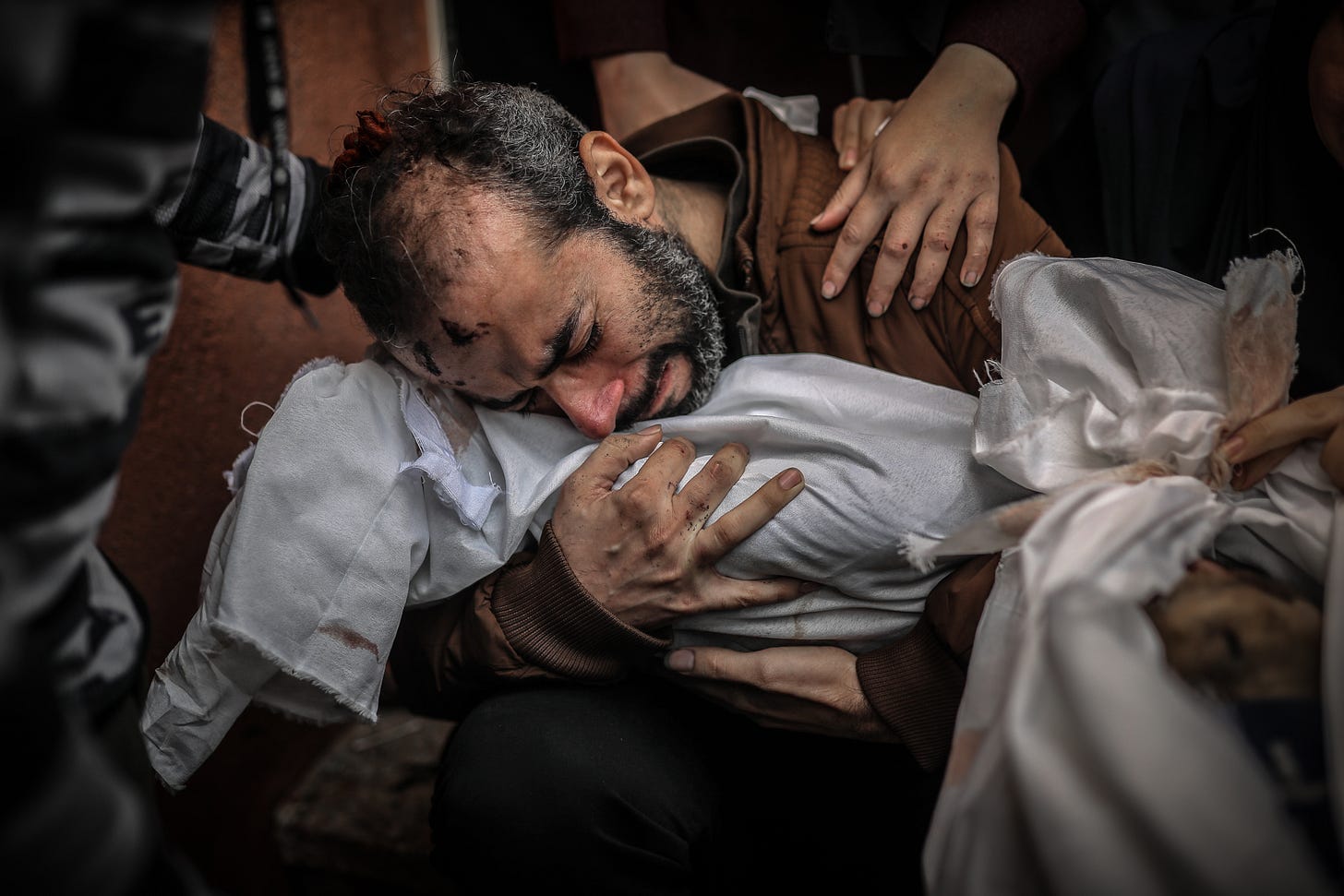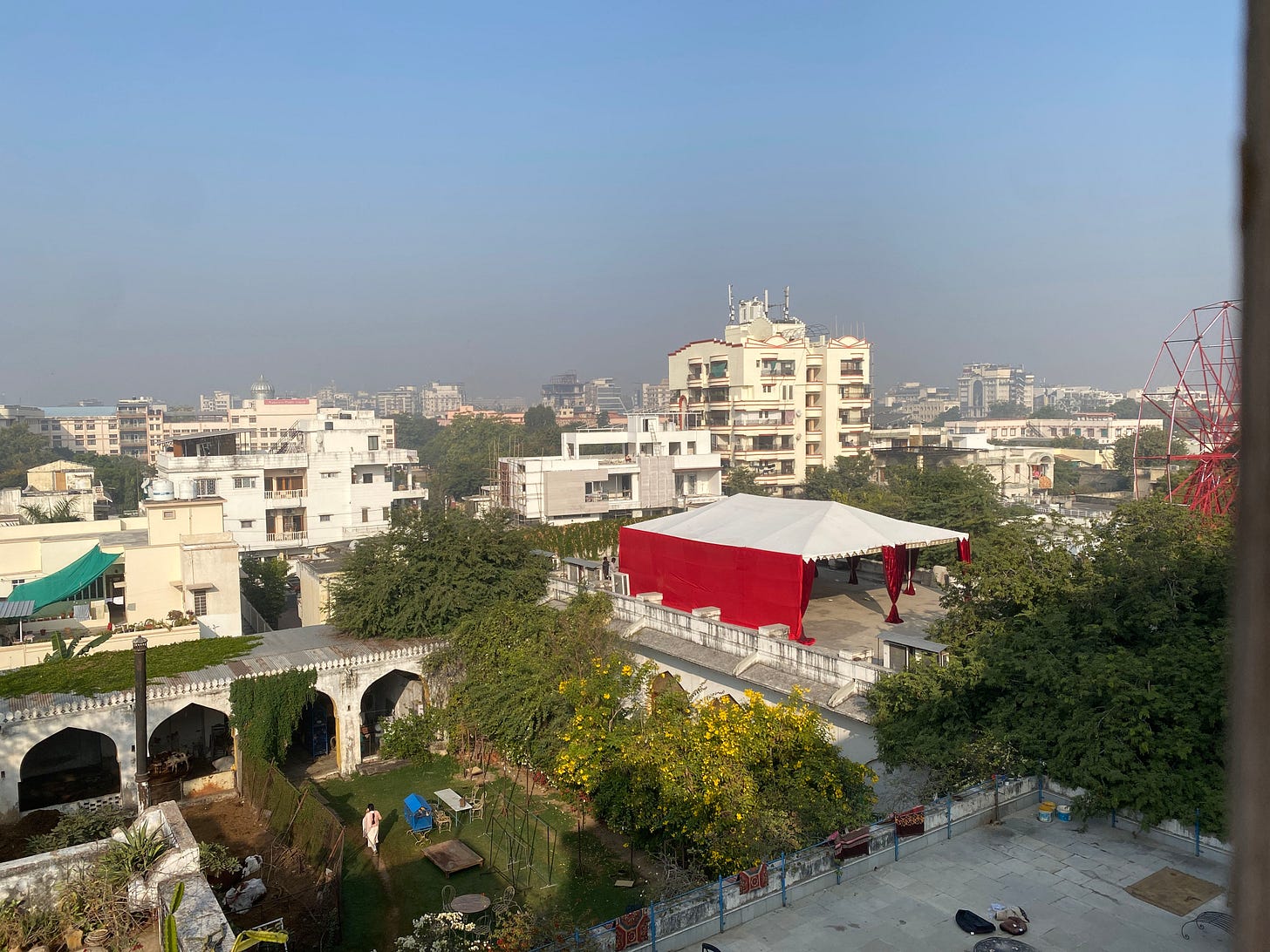It's Not Genocide. But It Is Infanticide.
At some point, a civilized country has to ask how many children it is prepared to kill.

“A civilization that fights tyrannical barbarism must know at what point its sins approach the barbarism of its foes. But it must also know at what points it is the custodian of values that transcend the sins of its ‘imperialism.’ Otherwise its uneasy conscience will betray it into the hands of those who have no moral scruples at all. It is a good thing to know what to do with an uneasy conscience,” - Reinhold Niebuhr.
The atrocities of October 7, committed by a fundamentalist, totalitarian terror-sect, were designed to replicate the anti-Semitic madness of the Holocaust — in the one place where this was never supposed to happen again. Like the architects of 9/11, the terrorists’ psychologically astute goal was to trigger the deepest fears of its victims, to terrorize into trauma and over-reach.
And in this respect, Hamas surely succeeded, just as al-Qaeda did. And how could they not? It is simply not human to experience a rape that violent and remain altogether sane in the aftermath. And, yes, just as we did over two decades ago, the Israelis have, understandably, lost their minds a little. The question, going forward, is whether they will lose their souls as well.
We told ourselves after 9/11 that we were in a battle between good and evil, and that we could only be on the side of the good. But we lost our way in our reaction afterwards; the war would have been more successful if we hadn’t; and the moral standing of the West rightly took a hit in the revelations of Gitmo and Abu Ghraib. What we are witnessing in Gaza right now is, I fear, driven by the same logic, the same zeal, and the same, self-defeating, if utterly understandable, moral blindness.
No, this is not genocide, as I have argued before. In fact, the charge of genocide seems to me inflammatory, even grotesque, deliberately equating Israel with the Nazis, in the tradition of the hate-filled international left. There is no evidence that Israel wants to exterminate the Arab race, in whole or in part, or even the Palestinian part of it. Hamas, in contrast, openly brags of its eliminationist anti-Semitism. The case made by the South African government in the Hague this week therefore went too far. But the evidence it presented — what we’ve been witnessing with our own eyes for three long months now — is disturbing enough.
Gaza is no more. It has been almost entirely leveled — a wasteland of mass death and destruction. Eighty-five percent of its population have fled their homes; 70 percent of those homes have been destroyed or heavily damaged. Gaza, unlike Dresden or Coventry in the Second World War, has also been besieged by Israel, which has deprived Gazans of water, electricity, and food. Famine and disease are beginning to strike. Most of the hospitals have been wrecked, and life-saving infrastructure is blown to smithereens. There is no way to evacuate children, as was done in the 1940s in both Britain and Germany; and the “safe zones” have turned into killing fields, because Hamas operates there as well, and can be targeted. In just three months, 23,000 human beings have been killed in Gaza, with civilians, especially women and children, vastly outnumbering Hamas operatives among the dead.
Because Hamas is not a nation-state capable of mounting a comparable counter-attack, we are also witnessing an inherently lopsided fight, where civilian losses among the Gazans are stratospherically higher than Israeli casualties. It’s not a war like the Allies and the Nazis where two forces matched; it’s a war in which one party already controls the entire ground of the other, has vastly superior air and land power, and can pound its enemy with relative impunity.
It therefore looks and feels like a relentless massacre. This is in part, of course, because Hamas deliberately uses civilians as fodder and human shields, and cynically maximizes civilian deaths for propaganda purposes. This too is different than other kinds of war, and it makes it close to impossible to defeat Hamas without massive civilian loss. Hamas bears ultimate responsibility for the carnage. The question is how much care Israel has been taking to minimize the collateral horror, in a population dominated by the young.
And there’s a lot we don’t know in the chaos and propaganda of the present. But compare the battle for Mosul in 2017, where ISIS used civilians in a similarly despicable pattern. At one point in the battle for the city,
Islamic State group fighters took thousands of civilians with them in their retreat west. They packed hundreds of families into schools and government buildings, sometimes shunting civilians through tunnels from one fighting position to another.
They expected the tactic would dissuade airstrikes and artillery. They were wrong. As the fight punched into western Mosul, the morgue logs filled with civilians increasingly killed by being “blown to pieces.” [...] The coalition has defended its operational choices, saying it was the Islamic State group that put civilians in danger as it clung to power.
The battle lasted for nine months. Out of a population of 1.5 million, more than 10,000 civilians were killed, around a third of which can be attributed to Coalition forces (with most of the deaths happening after the Coalition loosened its strict rules of engagement). So compare the estimated 3,500 civilian deaths over nine months in Mosul with the 23,000 deaths registered by Hamas (of whom the IDF claims 9,000 were terrorists) in just three months in Gaza, and you get a sense of the scale and intensity of the current bombardment. So we have 14,000 or so net civilian deaths in three months — giving the IDF the benefit of the doubt. Much worse than Mosul.
When you look at the impact on children, even if the numbers are inflated by the Palestinian Ministry of Health, far more have been slaughtered in Gaza in three months (9,000) as in the entire Iraq War over eight years (1,200). This was predictable. Gaza’s population is strikingly young: 47 percent are under 18 (compared with 22 percent in the US); about 40 percent are under 15 and a staggering 28 percent are under 10! When more than 15 percent of the population are toddlers, any full-scale war ineluctably becomes a mass, intense infanticide. And that is what is in front of our noses right now: thousands of dead children.
Most tellingly, back in 2017, the Coalition dropped just one 2000-lb bomb in the fight against ISIS — and investigated its use afterwards. In contrast, the IDF has dropped around five hundred 2000-lb bombs on Gaza. These bombs definitionally cannot surgically target terrorists; they kill or wound anyone up to 1,000 feet away.
Israel says they’re necessary to destroy Hamas’ tunnel network, which is, quite obviously, a completely legitimate war-aim. But still. Hundreds of massive, indiscriminate bombs in such a tiny, crammed place all but guarantees mass death of innocents. It is simply too easy to put all the blame on Hamas for this. CNN reported last month, “Nearly half of the [29,000] air-to-ground munitions that Israel has used in Gaza in its war with Hamas since October 7 have been unguided, otherwise known as ‘dumb bombs.’” This may not be genocide; but it sure pushes right up to the boundary of any legal or moral combat.
The very distinction between civilians and combatants — the key component of any just war theory — has been denied by the president of Israel himself, Isaac Herzog: “It’s an entire nation out there that is responsible. This rhetoric about civilians not aware, not involved — it’s absolutely not true. They could’ve risen up; they could’ve fought against that evil regime.” Including 9,000 kids?
A spokesman for the IDF said on October 10: “while balancing accuracy with the scope of damage, right now we’re focused on what causes maximum damage.” Defense Minister Yoav Gallant announced: “I have lowered all the restraints — we will kill everyone we fight against; we will use every means.” The Coordinator of the Government in the Territories Maj. Gen. Ghassan Alian said, as the war began: “Hamas became ISIS, and the citizens of Gaza are celebrating, instead of being horrified. Human beasts are dealt with accordingly … You wanted hell. You will get hell.”
Here’s Israel’s finance minister: “Gaza is an incubator of two million people who get up every morning and want to destroy, rape, and kill us all.” Netanyahu’s invocation of Amalek last October summons this passage from Scripture: “Now go, attack Amalek, and proscribe all that belongs to him. Spare no one, but kill alike men and women, infants and sucklings, oxen and sheep, camels and asses.” There is no genocidal intent in these various statements; but there is collective dehumanization and an endorsement of total violence in an environment crammed with innocents.
The rhetoric in Israel has been increasingly open about ethnic cleansing, and the current government is pouring funds into the West Bank settlements, enabling settler violence. This is not the Israel of the Rabin era:
On Nov. 14, Finance Minister Bezalel Smotrich said he supported “the voluntary emigration of Gaza Arabs to countries around the world.” Five days later, Intelligence Minister Gila Gamliel endorsed “the voluntary resettlement of Palestinians in Gaza, for humanitarian reasons, outside of the strip.” The Israel Hayom newspaper reported on Nov. 30 that Mr. Netanyahu had asked Strategic Affairs Minister Ron Dermer, one of his closest confidants, to develop a plan to “thin” the population in Gaza “to a minimum” by prying open Egypt’s doors and opening up sea routes to other countries.
We have literally seen IDF forces shooting Israeli hostages waving white flags and yelling in Hebrew. That’s how trigger-happy they have been, even as the military attempts at hostage rescue have only yielded one survivor so far. To make matters worse, TikTok contains videos of IDF soldiers misbehaving, some mocking the mass death around them. Not the rule — but a very ugly bunch of exceptions.
Look: Israel has every right to self-defense; Hamas violates every law of war; the terror-sect has no interest in a cease-fire; and any attempt to disarm and destroy Hamas in Gaza would be bound to harm civilians in terrible ways. Israel is in a very, very difficult place; and its enemies are the enemies of civilization. It’s too easy to condemn a war they have no option but to pursue, as Niebuhr would remind us.
But when you see the sheer scale of the punishment, the inherently indiscriminate nature of the bombing, the wholesale destruction of close to everything, the disproportionate impact on children, and the looming specter of mass starvation and disease, it’s hard not to conclude that we are witnessing a war crime that will further delegitimize Israel in the region and beyond. We are funding it, while we apparently have little control over it.
And to what end? We don’t know. The end-game is unclear. Re-occupation? Mass emigration? Who can say? Yes, Hamas can be physically destroyed. But support for it has soared since the war began; and I know of no person more committed to revenge than a parent whose child has been murdered. We were right to note how tight-knit Israeli society is, and how deep a trauma October 7 was for so many. Can we even imagine the psychological impact of 9,000 dead children? The Gazans are humans too. Am I being too sentimental in talking about infanticide rather than just civilian deaths? Not when the vulnerable population is so disproportionately young; not when just war theory would demand safety for every single one of them.
This is how it is when wars are launched swiftly, overwhelmingly, and in an understandable spasm of justified rage. Think of the position of Israel on October 8. The true evil of Hamas was exposed; most of the decent world grieved with Israel. Think of the long-term goals the Israelis could have achieved if they had taken a breath, thought deeply and strategically, and acted deliberately, in consort with their recently acquired Arab interlocutors.
Now look: a wasteland of death, a charge of genocide at the Hague, a huge propaganda loss in the wider world, 132 hostages still out of reach, and no coherent idea of what to do the day after, if the day after ever comes.
And maybe that day never will.
(Note to readers: This is an excerpt of The Weekly Dish. If you’re already a subscriber, click here to read the full version. This week’s issue also includes: a chat with Alexandra Hudson on the need for civility; a bunch of comments on the pod with Carole Hooven; dissents over my views on merit; six notable quotes for the week; 16 pieces on Substack we recommend on a variety of topics; a Mental Health Break of a rocking bagpipe; a beautiful wintry view of Sedona; and, of course, the results of the View From Your Window contest — with a new challenge. Subscribe for the full Dish experience!)
From a fence-sitter no longer:
I’ve been an unpaid listener to the Dishcast for a while now. After about the 20th time hearing your “just subscribe” message, I realized just how many excellent conversations I was missing out on. So even though I can only support so many independent journalists, I’ve decided the Dish deserves it. Thanks to you and Chris for all your hard work!
Another new subscriber writes, “As a lifelong liberal Democrat, the Dish is a vital antidote to a silo of left publications.”
New On The Dishcast: Alexandra Hudson
Alexandra is a journalist and public speaker. She’s the founder of Civic Renaissance, a newsletter and intellectual community dedicated to moral and cultural renewal. She’s also an adjunct professor at the Indiana University Lilly School of Philanthropy. Her first book is The Soul of Civility: Timeless Principles to Heal Society and Ourselves.
Listen to the episode here. There you can find two clips of our convo — on the moments when being civil is impolite, and the importance of indifference to others’ opinions. That link also takes you to a bunch of commentary on last week’s talk with Carole Hooven about her travails at Harvard, as well as dissents over DEI, which I respond to at length.
Browse the Dishcast archive for an episode you might enjoy (the first 102 are free in their entirety — subscribe to get everything else). Coming up: Jonathan Freedland on the war in Gaza, Jennifer Burns on her new biography of Milton Friedman, and Abigail Shrier on why the cult of therapy harms children. Please send any guest recs, dissents, and other pod comments to dish@andrewsullivan.com.
Dissents Of The Week: Define Merit
A reader dissents over my views on higher ed:
Framing the issue of Harvard as a matter of merit vs. diversity is a false paradigm. Given the long and profound history of prejudice against minorities and the barriers it created for members of those groups to have entry to good schools, some protections needs to be in place to ensure educational opportunity for everybody. In other words, it should be merit AND diversity.
I have no objections at all to schools searching far and wide for bright kids from minority backgrounds. But the best way to do this is via standardized tests, which the “equity” brigade want to dismantle. What I do object to is giving any single student a major boost solely because of her race.
Two more dissents are here, with my replies, and a bunch of criticism over DEI is on the pod page. Follow more Dish discussion on the Notes site here (or the “Notes” tab in the Substack app).
In The ‘Stacks
This is a feature in the paid version of the Dish spotlighting about 20 of our favorite pieces from other Substackers every week. This week’s selection covers subjects such as dentists, horror stories from post-Roe America, and DEI’s deadly potential in the airline industry. Below are a few examples:
Hein de Haas untangles “the false link between climate change and mass migration.”
Some tech optimism for 2024.
You can also browse all the substacks we follow and read on a regular basis here — a combination of our favorite writers and new ones we’re checking out. It’s a blogroll of sorts. If you have any recommendations for “In the ‘Stacks,” especially ones from emerging writers, please let us know: dish@andrewsullivan.com.
The View From Your Window Contest
Where do you think it’s located? Email your guess to contest@andrewsullivan.com. Please put the location — city and/or state first, then country — in the subject line. Proximity counts if no one gets the exact spot. Bonus points for fun facts and stories. The deadline for entries is Wednesday night at midnight (PST). The winner gets the choice of a VFYW book or two annual Dish subscriptions. If you are not a subscriber, please indicate that status in your entry and we will give you a free month subscription if we select your entry for the contest results (example here if you’re new to the contest). Happy sleuthing!
The results for this week’s window are coming in a separate email to paid subscribers later today.
See you next Friday.



